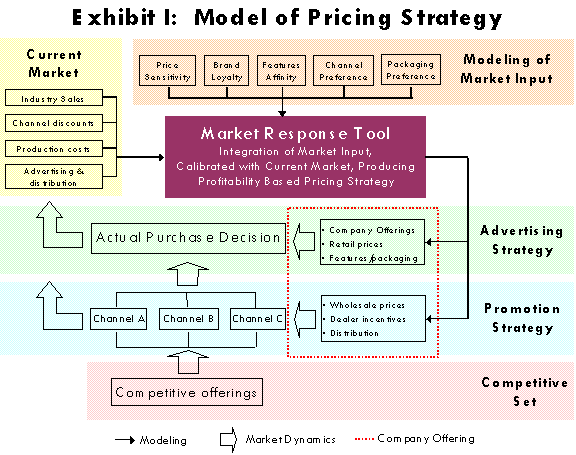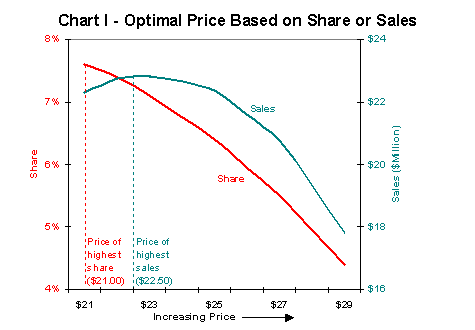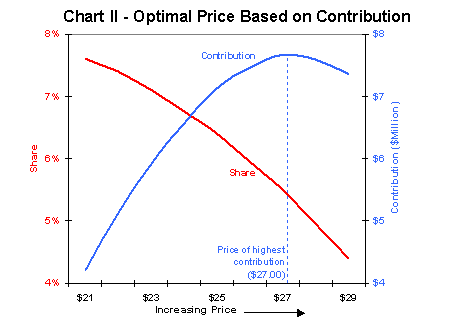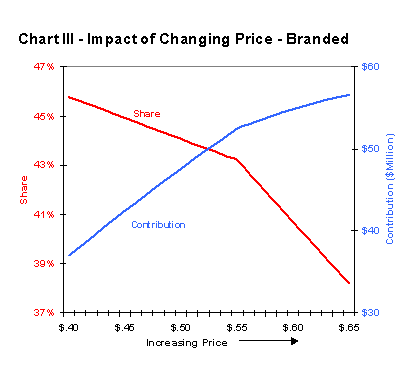|
Modeling Pricing Strategy
David Feldman Marketing Research. A Magazine of Management and Applications Winter, 2002
Strategic Pricing
In the overall marketing mix, price is the most important item that can affect a company's profitability. How to set prices and measure their impact on a company's business model, however, is less clear. Too many times, the focus of pricing is related to short-term competition or internal cost structure. Even if a company analyzes existing market data or collects new market input, this information usually doesn't provide links to profitability and other marketing-mix items. To develop an effective pricing strategy, it's important to first analyze a method of integrating meaningful customer input based on the entire company and competitive offerings within a category. This analysis should examine overall profitability and the trade-offs between the advertising and promotion strategies and allow management to get answers to the following types of questions:
- What set of prices will maximize profitability for all company offerings in a category?
- How can we bundle and price offerings to enhance overall profitability?
- For branded products, how can we effectively compete with value/generic offerings?
- How should our offerings and prices change in anticipation of the competition?
- If market constraints force development of sub optimal short-term strategies, how can we minimize the impact on positioning?
Traditionally, marketing's role in developing pricing strategy has been to understand market acceptance of price changes to new and existing products and services. Through the use of conjoint-type studies, researchers have learned about the trade-offs between brand, price, and features and leveraged customer value to develop pricing strategies. While this is valuable information, these types of research approaches don't do a good job of replicating the complexity of current marketplaces and extracting the real impact of price and price sensitivity. For example, conjoint creates an artificial marketplace that forces competitive offerings to contain similar features and prices, when, in reality, many unique products and services have different features and prices. Conjoint typically underestimates the impact of price and doesn't provide a value of price sensitivity by brand, but rather only in aggregate.
Pricing research typically focuses on a customer's preference for a specific offering and reports findings in terms of percentages. Given the lack of a complete set of competitive offerings of all products, services, and prices in the marketplace, it's hard to integrate preference measures to current market conditions and then accurately project changes in the marketing mix, especially in financial terms. This tends to lower the value of research because management can only make decisions on a relative "percentage" basis, rather than on an absolute "profit" basis. To develop a meaningful pricing strategy, researchers must integrate customer input on a complete competitive marketplace with how it interfaces with the distribution channel and variable costs.
Many organizations make pricing decisions based on secondary or syndicated data sources, internal costs, or competitive factors. While each of these items needs to be considered, profit potential and product equity can erode significantly with strategies based on these items alone. Some companies get input on customer's willingness to pay from measurements based on observed marketplace behavior. However, such measurements are limited because they only reflect existing product and service characteristics. In addition, observational data doesn't involve controls, so it can be difficult to separate the trends and sensitivities in the observed data from external items like product availability, promotion and advertising for the company, and competitive offerings.
While internal costs have a major impact on profitability, not linking them to market input on competitive pricing and customer willingness to pay can affect profits. It's unwise to develop a pricing strategy based on a reaction to customers leveraging one supplier over another to get the best possible price or a reaction to competitive price changes, internal sales goals, and inventory levels. These factors need to be considered in developing pricing strategies, but these strategies can hurt long-term profitability and product equity if they don't estimate market response and impact on sales channels and profitability.
Developing a Model
Effective pricing strategy is best developed through a profitability model that incorporates market input on a competitive marketplace, current market conditions, and impact of advertising and promotions. The results from this type of model will give specific direction on which new and existing offerings should be in the marketplace, how they should be packaged and priced, and how marketing investment should be allocated between advertising and promotion.
Consider the model of pricing strategy in Exhibit 1. The top half of the exhibit shows the model inputs of the customer and current market levels, and the bottom half represents the marketplace and the items a company has control over to optimize their offering. The overall process is broken down into four basic components: (1) modeling of market input, (2) calibrating model sensitivities to current market, (3) developing contribution measures, and (4) integrating with the overall marketing mix and developing profitability measures.
The first step is to develop the market sensitivities associated with price, brand, features, channel, and packaging-shown in the "Modeling of Market Input" section. These sensitivities relate to how the marketplace will react to changes in new and existing company and competitive offerings. Examples of changes that could be tested include the following:
- Changing of price for one or more company offerings within a category
- Branding a new offering with and without the company name
- Exclusivity of marketing through a single channel vs. all channels
- Impact of a package offering at different prices
- Offerings with and without certain features
- Competitive responses
The next step is calibrating model sensitivities to current market size. This step converts market shares to total dollars in the market by using industry sales from the current market. This is especially important when making pricing decisions in light of total R&D and marketing investments. With the calibration, the measures reported in the market response tool can show the impact on total sales as well as share.
Next, contribution measures need to be developed for all company offerings. This is done by integrating direct production costs with sales to determine contribution. Now the market response tool can optimize pricing and packaging strategies based on the total contribution rather than just share or sales.
The last step in the model is to tie other marketing-mix items into the market response tool. This step involves developing relationships that relate advertising and marketing expenditures to market levels of awareness and distribution. Also included here are any market or production constraints that need to be considered in developing pricing strategy. This step, along with the step relating to contribution, increases the value of market input because results are stated in direct financial terms and deal with the interaction between pricing and other items in the overall marketing mix.

Model of Market Input
An extremely important part of the model of pricing strategy is getting meaningful market input by collecting information in a way that parallels a customer's normal buying experience. Studies can be designed to precisely estimate separate value components. In addition, experiments can accommodate new brands, features, prices, and channels that currently don't exist in the marketplace. Discrete choice provides the best tools for developing pricing strategy in a designed experiment. When properly executed, it allows the researcher to present a complete portfolio of products and services that parallels current marketplace offerings. In addition, combinations of new and existing products and services can be tested in and out of the current marketplace, as well as changing prices and specific features for any offering in the marketplace.
Properly designing a discrete choice exercise that allows a survey to match the customer's actual purchasing experience is probably the single most important part of extracting market input to develop a model of strategic pricing. The critical step in this process is to review with management all possible scenarios they'd want to consider in the marketplace and then designing the study to allow testing for these different scenarios. For example, if management wants to test a new offering, they may want to consider multiple scenarios of (a) adding it to its current portfolio, (b) having it replace one or more existing products and services, or (c) not introducing it at all because it might cannibalize their more profitable current offerings. At the same time, management wants to know which prices and specific features, along with any packaging alternatives, will optimize their portfolio.
In general, the key components of the design involve multiple price levels for the company's and key competitor offerings, along with testing of certain products and services both in and out of the marketplace. Products and services are tested in and out of the marketplace to determine which offerings will lose share when a new product or service is added as well as which offerings will gain share when a product or service is no longer in the market. Prices can be different for all products and services being tested and should reflect current market prices. The ranges of prices must be wide enough to allow proper sensitivity testing and future use of the market response tool.
It's important to understand how the market values the different components of an offering. For certain studies, part of the design needs to include options for de-bundling an offering, as well as the combination of multiple products and services combined in a package offering. In both cases, multiple levels of price would need to be tested for each de-bundling and package offering. Another consideration for the design is allowing respondent choices to be recorded in a way that matches how customers would normally make choices. In addition, respondents should not only indicate which offering, but also indicate some volumetric measure such as "how many" or "how often."
Once the survey has been properly designed and executed, market sensitivities need to be derived from customer input. As indicated in Exhibit 1, the modeling of market input must analyze the choices the respondents gave to specific market conditions and convert them into measures of price sensitivity, brand loyalty, feature affinity, channel, and packaging preference. Developing segments of respondents who exhibit similar market sensitivities helps discrete choice maintain a high level of heterogeneity, and better understanding of the unique needs of target segments. As an example, a certain segment may be defined as customers who prefer a certain feature or package and are rather insensitive to price.
To increase the accuracy of the survey model, and to link market shares to total units in the marketplace, the market response tool derives a base case that reflects current prices and availability of products and services. It's then compared to known market shares and market sizes at the same prices and availabilities. This is a very important step in bridging the richness of market input with the accuracy of known market information. No matter how good the sampling and however realistic the survey matches the actual buying experience, this step ensures all projections are based on an agreed-upon starting point. The key for the survey is to derive sensitivities from market input and then to put this information into a context that management can understand and then use to develop an effective pricing strategy.
Measures of Profitability
If only market shares are considered, and a new offering completely cannibalizes from the existing company set of products and services, then a decision might be made not to launch. However, if the new offering has a higher profit contribution, then it may be beneficial to launch it. The value of being able to develop strategy based on profit vs. market share is more dramatic when considering a price to charge for a product or service.
Consider Exhibits 2 and 3, which show the impact that changes in a company's price have on share, sales, and contribution. These exhibits represent findings from an actual research study. In Exhibit 2 there are two curves. The curve labeled "share" shows the forecasted share of a product/service at different prices, starting from $21 to $29, which were the prices tested in the survey.
If you wanted to maximize your share, Exhibit 2 indicates that you should offer your product/service at the lowest price tested: $21. Unless the offering is priced so low that customers question its quality, the lowest price will always produce the highest share. If the optimization criterion is based on sales, rather than share, the price that maximizes sales is $22.50. This increases total sales to approximately $23 million, as opposed to $22 million at a price of $21.
Exhibit 3 shows the same share curve, but adds a curve for company contribution. The price that maximizes company contribution is $27, which projects a contribution of $7.7 million. Comparing $7.7 million to the contribution based on the price that maximizes sales, which is $22.50, company contribution improves by 40%.
Not only does optimization based on contribution increase overall profitability, but these strategies will be more stable over time compared to those developed based on sales. To begin with, just redirecting the focus of the marketing program to maximize contribution vs. sales takes into consideration company margins and impact on cannibalization. This focus ensures the pricing strategies are optimized based on a company's overall offering, costs, and prices, rather than on what price is going to be more attractive than that of the competitors. Even if the competitors lower their prices, in most cases, original pricing based on profitability will still be the optimal price as compared with a lower price that meets the competitor's price.
Exhibit 2

Exhibit 3

Overall Marketing Mix
To enhance the results from modeling market input, management must be able to adjust forecasts based on assumptions of levels of advertising and promotion. Some measures that need to be considered include (1) level of advertising and its impact on awareness, (2) level of distribution and its impact on volume, and (3) level of dealer incentives and promotions and its impact on channel response.
In many cases, ascertaining the relationship between advertising and promotion and their market responses might require comprehensive studies. Whether these relationships exist or not, the pricing model must allow management to at least be able to enter assumptions as to how the market will react to changes in their advertising and promotion. By entering "worst case" to "best case" ranges for these relationships, along with varying levels of advertising and promotion, the market response tool can determine what impact these items have on pricing strategy and overall profitability.
In addition to integrating marketing-mix items into the model of pricing strategy, certain internal and marketplace constraints might affect pricing strategy. Types of constraints that might need to be considered include (1) supply constraints, (2) impact of major price changes on competitive responses, (3) difficulty in changing current prices in marketplace, (4) order of entry for new products, and (5) external regulation.
These are integrated into the model through the addition of secondary optimization criteria. In most cases, the primary optimization is associated with overall company profitability in the category. However, because the model can provide a list of alternative pricing and packaging strategies sorted by profitability, it can identify the best alternative by locating the highest profitability subject to the necessary optimization criteria.
Case Study
This case study involves a leading pharmaceutical product that was approaching the end of its patent protection. Besides the potential for generics to come into the market, there were some safety concerns fueling new product development. Overall market size had been growing due to initial direct-to-consumer (DTC) advertising and anticipation of lower priced alternatives and safer products. Specific study objectives follow:
- Measure the impact of generics
- Decide whether the company should develop a private label offering
- Determine the pricing strategy for current market leading branded product with and without a generic entry and/or new product entrants
- Measure demand for new safer alternatives
- Measure the potential increase in size of market due to lower prices and safer products
- Develop a five-year planning tool integrating the alternative pricing strategies, impact of DTC, investment requirements in new products and market size estimates
To meet the research objectives, the modeling of market input was based on a two-step procedure. First, the survey collected prescribing behavior based on a market with and without a generic at different prices for the key products in the market. Then for each initial question, an additional question was asked to determine how the prescribing behavior would change based on the availability of new products with higher safety claims.
The modeling of market input provided measures of price sensitivity, affinity for prescribing a generic, and preference for prescribing new products with higher safety claims. Through comparison of base cases with no generic, initial shares for all products in the market were calibrated to match known market shares. Total market size, in terms of prescriptions, was overlaid into the market response tool so total prescriptions and sales could be shown. In addition, production costs for clients' products were included so total contribution could be shown for all clients' products.
Because the client had no prior experience with a private label, a relatively simple relationship was developed to forecast what percent of the generic market the client's private label offering would achieve. A straight-line relationship emerged between two price points: A low price that would ensure the client private label would get 100% of the generic market and a high price so expensive the client private label wouldn't get any part of the generic market. These two price points were $.20 and $.40, and the results from integrating this relationship into the market response tool indicated an optimal pricing to the channel of $.25. Based on a 15% lower price for the generic alternative, generics were projected to get 50% of the branded product's share. With a $.25 private label offering, the client's projected share loss of 50% would be reduced to only 30%. The price sensitivities for the client's branded product can be seen in Exhibit 4.
Exhibit 4 shows how contribution can improve as price rises from the current price of $.55 to $.65. In addition, if generics are introduced in the marketplace, then they'll be priced as a percent of the client's branded product. Therefore, by raising prices, the generic pricing would also be higher, which would improve the margins for the client's private label offering. At the proposed $.65, the impact of a generic offering that was originally priced at 50% lower than the client's product would now be a 20% reduction in contribution based on the higher price and the private label offering.
Interest in the new products with higher safety claims was very high, and the client's offering was projected to be twice the size of the other entrants. Before making a decision on moving ahead with the new product offering, management needed to consider the following items: (1) impact on market size due to introduction of product with safer product claim, (2) impact of DTC advertising, (3) impact on cannibalization on current branded product, (4) cost to develop and test new product, (5) impact of generic and branded product pricing, and (6) impact of competitive responses.
A five-year planning tool was integrated into the market response tool that allowed entry of assumptions associated with each of the six items mentioned here. For each of these items, estimates were developed by year for a five-year period. Then, based on these assumptions, the planning tool determined the five-year net present value associated with the overall company's contribution in the category. Even though the company's new product offering was better than the other new offerings in the market, the company was projected to attain higher contribution by not making the investment in this new product. The recommended strategy was to focus on DTC advertising for the category and implement suggested pricing strategies and the private label offering.
Exhibit 4

Implementing the Model
Implementation of this approach requires a commitment to the entire process. These models are developed in a highly customized manner and vary across industries. At times, the company and industry information needed to design and implement them aren't readily available. In addition, multiple disciplines need to come together to integrate current market conditions, market sensitivities, and profitability into one model.
To overcome these difficulties and develop a model of strategic pricing, it's important to communicate the benefits of this model so everyone shares a similar goal in terms of pricing strategy. Support for the effort must be the organization's top priority. Management must then create an environment that encourages marketing managers, product managers, and finance managers to develop the necessary inputs and to work together to develop the optimum strategies. This is a large mountain to climb, but the benefits of a comprehensive pricing strategy compared to on-going reactive pricing can be tremendous.
|

